|
|
Picasso's "Secret" Guernica * |
|
 If you've found this site useful, we'd really appreciate a small donation to help with the hosting costs. Thanks! |
On April 26th 1937, a massive air raid by the German Luftwaffe on the Basque town of Guernica in Northern Spain shocked the world. Hundreds of civilians were killed in the raid which became a major incident of the Spanish Civil War. The bombing prompted Picasso to begin painting his greatest masterpiece... Guernica.
The painting became a timely and prophetic vision of the Second World War and is now recognised as an international icon for peace. Despite the enormous interest the painting generated in his lifetime, Picasso obstinately refused to explain Guernica's imagery. Guernica has been the subject of more books than any other work in modern art and it is often described as..."the most important work of art of the twentieth century", yet its meanings have to this day eluded some of the most renowned scholars. Four years research into an unauthenticated Picasso drawing of a crucifixion, dated 12 May, 1934, has provided a wealth of new information about Picasso's use of symbolism. The study has also led to some remarkable discoveries about Guernica... listed here are a few examples. The images are being shown for the first time. They have never been seen in any prior publication about Guernica, or its creator.
Guernica's "Secret" Harlequins"Experts," now agree that Picasso practised a form of art-magic, linked to this was Picasso's Harlequin. In 1932 another famous twentieth century magician, C.G.Jung... recognised Picasso's Harlequin as an underworld character, a master of disguise associated with the occult. Picasso identified with Harlequin whom he also associated with Christ due to the character's mystical power over death. In Picasso's "secret" Guernica, he has invoked a number of unseen Harlequins to overcome the forces of death represented in the painting.
The outline of the face can be seen in the lines and background tones of the composition, the eyes and the tuft of hair to the right of the face are clearly visible.
The Harlequin appears to be crying a diamond tear for the victims of the bombing. The diamond is one of the Harlequin's symbols and in Picasso's work it is a personal signature. Painters often rotate or invert paintings to check balance and stability in the composition. Picasso knew from this and from his Cubist experiments that sideways or inverted imagery could have a powerful subliminal effect on the viewer and give a work hidden meanings and magical secrecy.
From this viewpoint, Harlequin's hat becomes obvious as the figure appears to look upwards at the sky as if in reference to the bombing.
The outline of the face and traditional hat and mask make him identifiable. Picasso hid many magical images in his work by incorporating them sideways or upside down. Sometimes, as in this case, he placed other images over the top as camouflage.
This Harlequin is identifiable by his triangular hat and serrated collar. He is constructed from components of Punch and Judy theatre. The hat is peaked with a crocodile's jaw and his square mouth and face when viewed the right way up takes on the form of a traditional puppeteer's theatre.
The Crocodile and the Harlequin are common characters in Punch and Judy shows, their inclusion in Guernica stems from Picasso's love of puppetry which began before the turn of the century in Barcelona where he saw many such shows and even helped produce them with Pere Romeu at Els Quatre Ghats . The figure falling across the Harlequin's face which is often assumed to be a woman, in fact bears a strong resemblance to Picasso, who appears to be identifying with the victims of the bombing.
He is identifiable from his patchwork costume and triangular hat and appears to be kneeling on the ground as if watching the puppet show taking place opposite.
Guernica's Hidden Images of Death
The skull is shown sideways and has been ingeniously overlaid onto the body of the horse, which is also a death symbol. The skull's mechanical appearance seems appropriate to the modern weaponry used in the 1937 bombing. Picasso often hid one or more related symbols within a particular image as seen here.
This image, like the concealed caricature of Hitler (not discussed in this article) was first identified by Mel Becraft, the inspired Guernica scholar and author of "Picasso's Guernica, Images within Images" (1987, 2nd Ed.) All these findings have come about from studying the "unauthenticated" 1934 Picasso drawing.
* Published in the interests of cultural and artistic understanding. © Mark Harris 1995-6 Related Picassos
Next Section: Themes of the 1934 Drawing |
|
|
|
     |
     |
|
|
© Mark Harris 1996 (content), Simon Banton 1996 (design) In general copyright of works by Pablo Picasso are the property of the heirs to the Pablo Picasso estate |
|


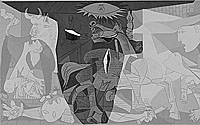 This is the largest Harlequin, which is cleverly hidden behind the surface imagery.
This is the largest Harlequin, which is cleverly hidden behind the surface imagery. The next Harlequin is easily recognisable as the painting is rotated 90 degrees to the right.
The next Harlequin is easily recognisable as the painting is rotated 90 degrees to the right.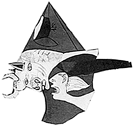 This is another Harlequin, seen by rotating the painting 90 degrees to the left.
This is another Harlequin, seen by rotating the painting 90 degrees to the left. This fourth Harlequin has been concealed by inversion, which is a common technique of encryption in Hermetic magic.
This fourth Harlequin has been concealed by inversion, which is a common technique of encryption in Hermetic magic.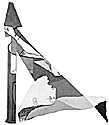 The next Harlequin image is again inverted and can be seen to the right of the previous Harlequin.
The next Harlequin image is again inverted and can be seen to the right of the previous Harlequin.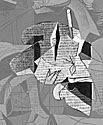 The preoccupying theme of Guernica is of course death; reinforcing this, in the centre of the painting is a hidden skull which dominates the viewer's subliminal impressions.
The preoccupying theme of Guernica is of course death; reinforcing this, in the centre of the painting is a hidden skull which dominates the viewer's subliminal impressions.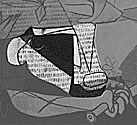 Below the dying horse in the centre of the painting is a concealed bull's head contained in the outline of the horse's buckled front leg. Its location infers that that it is plunging its horns into the horse's belly from below... the goring of the horse in the bullfight was a favourite subject for Picasso and has strong sexual overtones.
Below the dying horse in the centre of the painting is a concealed bull's head contained in the outline of the horse's buckled front leg. Its location infers that that it is plunging its horns into the horse's belly from below... the goring of the horse in the bullfight was a favourite subject for Picasso and has strong sexual overtones.